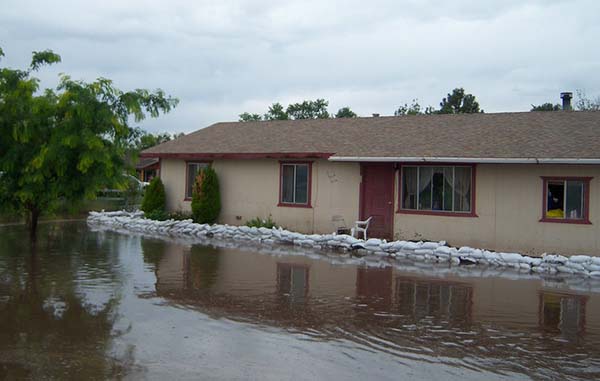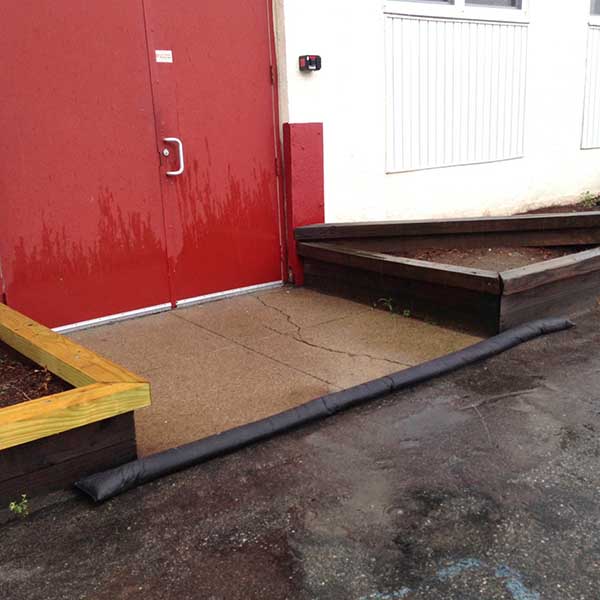When laid properly, sandbags are very effective at diverting water and preventing flood damage. The problem is that laying sandbags is backbreaking and time-consuming work. You also need to have enough sand on hand. Sand can be impossible to get right before a flood is set to hit!
For these reasons, it’s not unrealistic for many homeowners to sandbag their entire home or even doorways before a flood.
Luckily, flood protection technology has gotten better over the years. There are now many residential sandbag alternatives that can be deployed quickly and easily. I’ll go over the options here and their pros/cons.

Also read:
1. Water-Filled Dams and Barriers

These flood barriers are made of tarp-like materials. You lay the dam where you want it to go and then fill it with water.
Water-filled dams became popular after a 2016 story about a man who saved his home from flooding with an AquaDam. However, water dams don’t always work. There are stories of homeowners spending thousands of dollars for water dams only to have them fail (such as Sam Craven’s $13k dam).
A water dam generally protects against water up to ¾ of its height. They only work well on even, flat ground. If stored for long periods, the folded areas weaken and can break under pressure. Water dams also take a long time to fill and require lots of water for large dams.
Pros:
- Reusable
- Lightweight for size and store compactly
- Come in various sizes
Cons:
- Take a long time to fill and require water
- Can be punctured by debris
- Expensive
- Don’t work well on uneven ground
Recommended Products:
2. Air-Inflatable Flood Tubes
These are similar to the flood barriers above, but they are filled with air instead of water. To prevent them from floating up, they have a skirt. When flood water covers the skirt, it weighs the tube down.
There aren’t too many options, and they are expensive. To fill the tube, you will need an air pump, which means you need a reliable emergency power method for the pump in case of a power outage. You can see in the video below how one solution works.
Pros:
- Reusable
- Lightweight for size and store compactly
- Suitable for large spaces
Cons:
- Require air pump
- Can be punctured by debris
- Expensive
- Don’t work well on uneven ground
3. Water-Activated Flood Barriers

Also called “sandless sandbags” or “gel sandbags,” these are tubes or bags containing material that swells when it comes in contact with water.
Because they contain a fill material, water-activated barriers aren’t as compact for storage as inflatable barriers. However, they aren’t as susceptible to punctures. They are also very quick to deploy. The material will swell to fit uneven ground or round areas.
Most are tube-shaped or sandbag sized. This makes them ideal for protecting doorways, garage doors, and basement windows from flood water. They can also be used to divert water away from a home. However, they will only work if laid out properly. The amount of flood protection is limited to the height of the product or how high you stack bag-style barriers.

Note that some brands advertise their products as reusable. Flood water contains lots of harmful pathogens, such as sewage. You should throw away barriers that have come in contact with flood water, so they are not really reusable!
Pros:
- Quick to deploy
- Lightweight, compact and easy to transport
- Come in many sizes and lengths
- Work on uneven ground
- Flexible to fit various shapes
Cons:
- Not reusable
- Only a few inches of protection
- Must know how to stack them properly
Recommended Products:
4. Straw Bales
Straw bales are a cheap solution for sediment control, especially on sloped land. Place them around the perimeter of the land to prevent soil washout during heavy rains and floods.
It’s also possible to use straw bales to make a temporary flood barrier. Place the bales around the property and weigh them down with sandbags. The bales swell when they come in contact with water, making them watertight.
But straw bales are not without their downsides. They are ineffective at stopping high volumes of water. They are also susceptible to rotting and get moldy after about 6 months. For more info on installing straw bale barriers, see these guides from MA Clean Water Toolkit and Mile High Flood District.
Pros:
- Affordable
- Suitable for large properties
- Stop sediment runoff
- Can divert water
Cons:
- Not completely watertight
- Get moldy
5. Flood Panels for Doors and Windows

These are panels that you put in front of doors or basement windows before a flood. They are completely watertight and prevent water from getting through. Depending on the panel type, you may need to install a rail or frame to hold the panel in place.
While flood panels do a good job of preventing water from getting in through doorways and windows, they don’t stop water from getting in through other ways. Water will seep through cracks in the foundation, go up through the sewer etc.
Pros:
- Reusable
- Quick installation
Cons:
- Don’t protect perimeter or foundation of property
- Expensive
Recommended:
6. Tarp L-Shaped Flood Barriers
Cities often use modular L-shaped barriers made out of plastic to control flood water. These barriers generally aren’t practical for residential properties, though. They are expensive and take up a lot of storage space. A good alternative is L-shaped barriers made from tarps or PVC sheeting.
The top of the tarp is propped up with a back wall or metal brackets. The bottom of the tarp is set along the ground, facing the direction of the flood water. When water flows over the bottom of the tarp, it anchors the tarp in place.
There are many ways to make your own L-shaped tarp barrier. For example, the setup here uses straw bales as a back wall. You can buy kits, but they tend to be pricy.
Many homeowners use their own home as a back wall for supporting the tarp. However, this can backfire: if water seeps through the barrier, the tarp can lock the water inside the home instead of keeping it out.
For more, read How to Make a DIY Tarp Flood Barrier
Pros:
- Protect perimeter of property
- Don’t take up much storage space
- Some cheap DIY solutions
Cons:
- Prone to failure
- Learning curve to set up properly
7. Permanent Flood Barriers
If you live somewhere prone to flooding and have a large property, you may consider constructing a permanent barrier, such as a levee, bund, or floodwall.
When properly constructed, these can be very effective against flooding. However, flood control is a complicated science, so you will need an engineer to design the project. Permanent barriers can be unsightly and may even be prohibited under zoning laws.
Pros:
- Effective at protecting entire property
- Permanent solution
- No need to deploy anything before flooding
Cons:
- Expensive
- Require engineer
- Possible eyesore
- Zoning and permitting requirements
8. Floodproofing
Before investing in flood barriers, you may want to consider floodproofing your home instead. Sometimes, minor modifications can make a big difference in preventing flood damage. Some floodproofing measures include:
- Sealing cracks in foundation and walls
- Keep gutters clean
- Clear floor drains of obstructions
- Install flood vents
- Install sump pump
- Fit non-return valves to all drains and water inlet pipes
- Make a rain garden
- Reduce impervious surfaces on property







